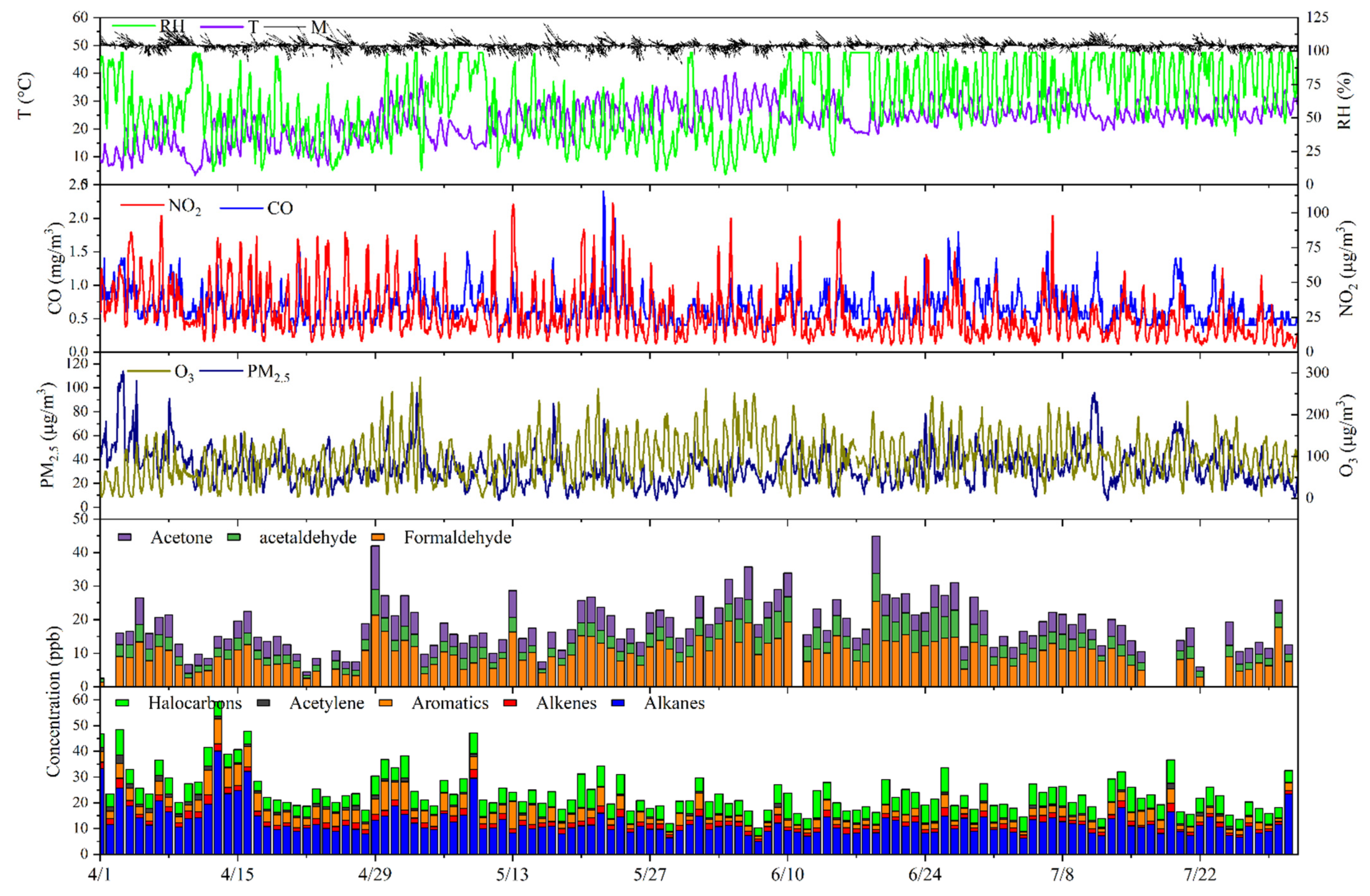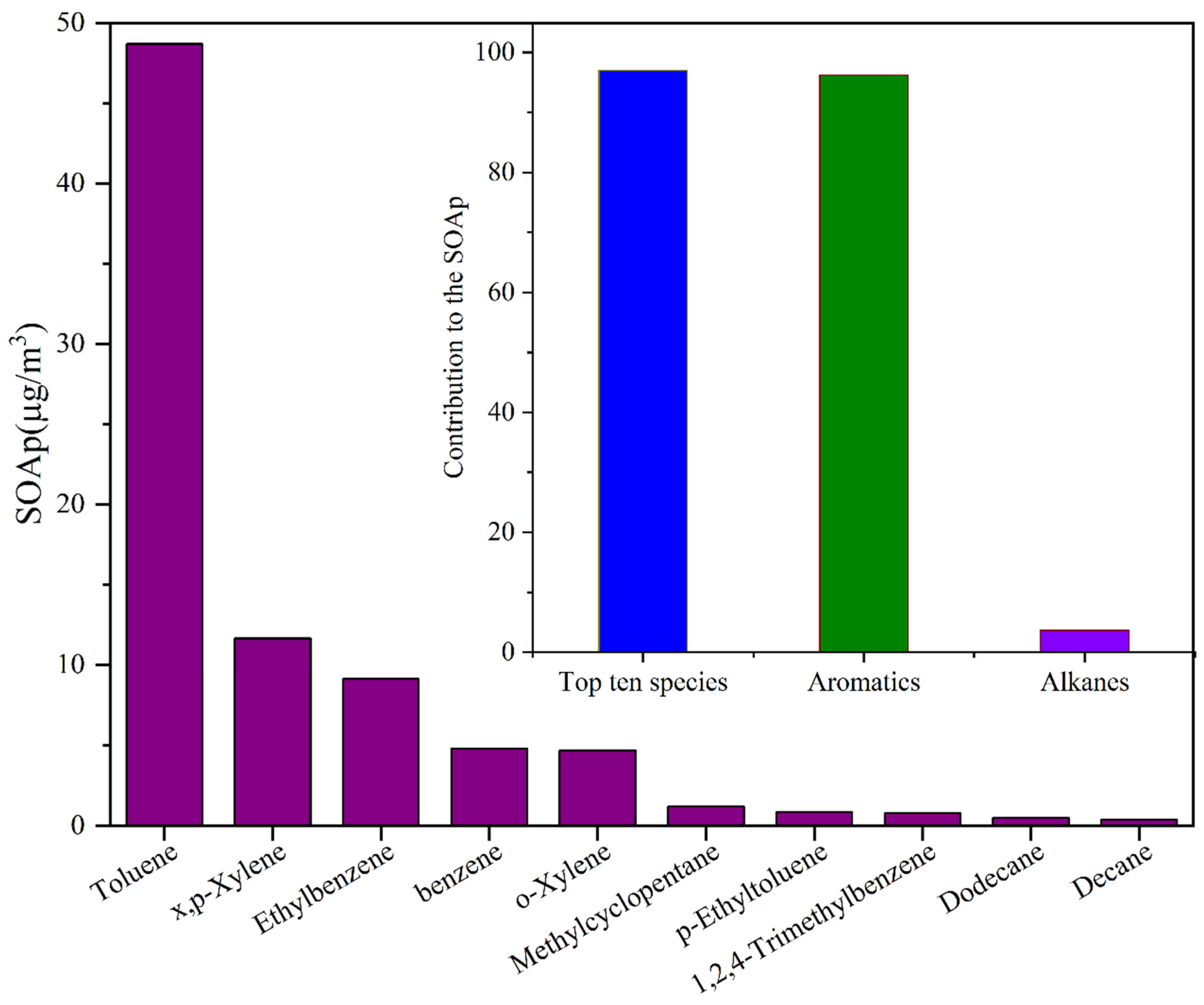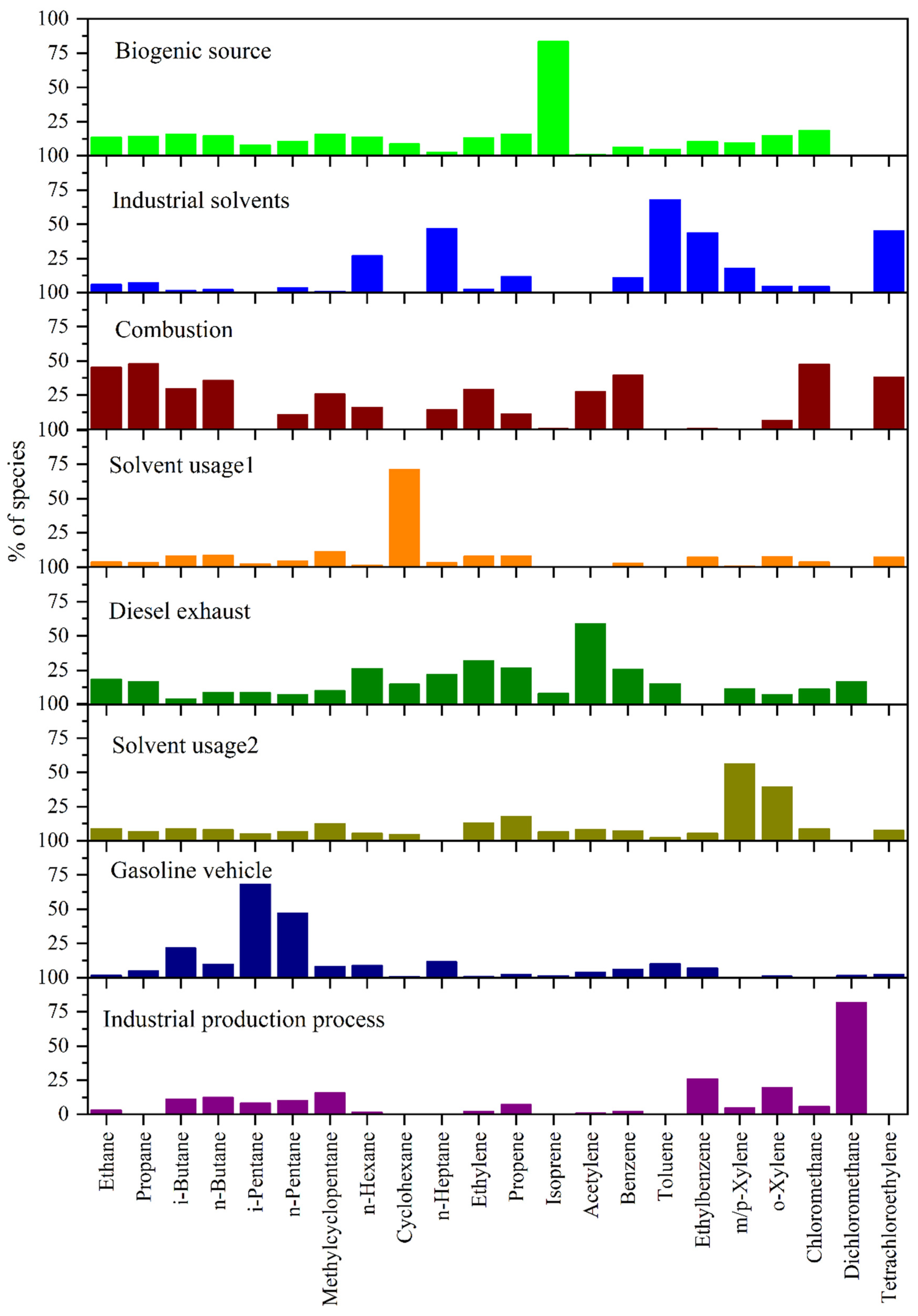Characteristics of Volatile Organic Compounds and Their Contribution to Secondary Organic Aerosols during the High O3 Period in a Central Industry City in China
Abstract
:1. Introduction
2. Materials and Methods
2.1. Sampling Site and Observations
2.2. Analysis of VOCs
2.3. Other Data
2.4. Positive Matrix Factorization (PMF)
2.5. SOAp
3. Results and Discussion
3.1. Overview of Observation Results
3.2. The Influence of Meteorological Parameters
3.3. The Contribution to SOAp
3.4. Source Identification
4. Conclusions
Supplementary Materials
Author Contributions
Funding
Institutional Review Board Statement
Informed Consent Statement
Data Availability Statement
Acknowledgments
Conflicts of Interest
References
- Han, D.; Gao, S.; Fu, Q.; Cheng, J.; Chen, X.; Xu, H.; Liang, S.; Zhou, Y.; Ma, Y. Do volatile organic compounds (vocs) emitted from petrochemical industries affect regional PM2.5? Atmos. Res. 2018, 209, 123–130. [Google Scholar] [CrossRef]
- Zhan, J.; Feng, Z.; Liu, P.; He, X.; He, Z.; Chen, T.; Wang, Y.; He, H.; Mu, Y.; Liu, Y. Ozone and soa formation potential based on photochemical loss of vocs during the beijing summer. Environ. Pollut. 2021, 285, 117444. [Google Scholar] [CrossRef] [PubMed]
- Liu, S.; Ahlm, L.; Day, D.A.; Russell, L.M.; Zhao, Y.; Gentner, D.R.; Weber, R.J.; Goldstein, A.H.; Jaoui, M.; Offenberg, J.H.; et al. Secondary organic aerosol formation from fossil fuel sources contribute majority of summertime organic mass at bakersfield. J. Geophys. Res. Atmos. 2012, 117, D24. [Google Scholar] [CrossRef] [Green Version]
- Rao, Z.; Chen, Z.; Liang, H.; Huang, L.; Huang, D. Carbonyl compounds over urban beijing: Concentrations on haze and non-haze days and effects on radical chemistry. Atmos. Environ. 2016, 124, 207–216. [Google Scholar] [CrossRef]
- Gao, Y.; Wang, H.; Zhang, X.; Jing, S.; Peng, Y.; Qiao, L.; Zhou, M.; Huang, D.; Wang, Q.; Li, X.; et al. Estimating secondary organic aerosol production from toluene photochemistry in a megacity of China. Environ. Sci. Technol. 2019, 53, 8664–8671. [Google Scholar] [CrossRef] [PubMed]
- Peng, J.; Hu, M.; Du, Z.; Wang, Y.; Zheng, J.; Zhang, W.; Yang, Y.; Qin, Y.; Zheng, R.; Xiao, Y.; et al. Gasoline aromatics: A critical determinant of urban secondary organic aerosol formation. Atmos. Chem. Phys. 2017, 17, 10743–10752. [Google Scholar] [CrossRef] [Green Version]
- Wu, R.; Xie, S. Spatial distribution of secondary organic aerosol formation potential in China derived from speciated anthropogenic volatile organic compound emissions. Environ. Sci. Technol. 2018, 52, 8146–8156. [Google Scholar] [CrossRef] [PubMed]
- Yang, W.; Yu, Q.; Pei, C.; Liao, C.; Liu, J.; Zhang, J.; Zhang, Y.; Qiu, X.; Zhang, Y.; Zhang, Y.; et al. Characteristics of volatile organic compounds in the pearl river delta region, China: Chemical reactivity, source, and emission regions. Atmosphere 2022, 13, 9. [Google Scholar] [CrossRef]
- Wang, S.; Wu, D.; Wang, X.-M.; Fung, J.C.-H.; Yu, J.Z. Relative contributions of secondary organic aerosol formation from toluene, xylenes, isoprene, and monoterpenes in hong kong and guangzhou in the pearl river delta, China: An emission-based box modeling study. J. Geophys. Res. Atmos. 2013, 118, 507–519. [Google Scholar] [CrossRef] [Green Version]
- Zhang, H.; Chen, C.; Yan, W.; Wu, N.; Bo, Y.; Zhang, Q.; He, K. Characteristics and sources of non-methane vocs and their roles in SOA formation during autumn in a central chinese city. Sci. Total Environ. 2021, 782, 146802. [Google Scholar] [CrossRef] [PubMed]
- Huang, X.; Wang, C.; Zhu, B.; Lin, L.; He, L. Exploration of sources of ovocs in various atmospheres in southern China. Environ. Pollut. 2019, 249, 831–842. [Google Scholar] [CrossRef] [PubMed]
- Rodriguez, A.A.; de Loera, A.; Powelson, M.H.; Galloway, M.M.; De Haan, D.O. Formaldehyde and acetaldehyde increase aqueous-phase production of imidazoles in methylglyoxal/amine mixtures: Quantifying a secondary organic aerosol formation mechanism. Environ. Sci. Technol. Lett. 2017, 4, 234–239. [Google Scholar] [CrossRef]
- Wu, W.; Zhao, B.; Wang, S.; Hao, J. Ozone and secondary organic aerosol formation potential from anthropogenic volatile organic compounds emissions in China. J. Environ. Sci. 2017, 53, 224–237. [Google Scholar] [CrossRef] [PubMed]
- Feng, J.; Yu, H.; Su, X.; Liu, S.; Li, Y.; Pan, Y.; Sun, J. Chemical composition and source apportionment of PM2.5 during chinese spring festival at xinxiang, a heavily polluted city in north China: Fireworks and health risks. Atmos. Res. 2016, 182, 176–188. [Google Scholar] [CrossRef]
- Feng, J.; Yu, H.; Mi, K.; Su, X.; Li, Y.; Li, Q.; Sun, J. One year study of PM2.5 in xinxiang city, north China: Seasonal characteristics, climate impact and source. Ecotoxicol. Environ. Saf. 2018, 154, 75–83. [Google Scholar] [CrossRef] [PubMed]
- Yan, G.; Zhang, P.; Huang, H.; Gao, Y.; Zhang, J.; Song, X.; Zhang, J.; Li, H.; Gao, Z.; Jiang, Z.; et al. Concentration characteristics and source analysis of PM2.5 during wintertime in Zhengzhou-Xinxiang. Huanjing Kexue 2019, 40, 2027–2035. [Google Scholar]
- Zhou, Y.; Duan, W.; Chen, Y.; Yi, J.; Wang, B.; Di, Y.; He, C. Exposure risk of global surface o3 during the boreal spring season. Expo. Health 2022, 14, 431–446. [Google Scholar] [CrossRef]
- Jia, S.; Zhou, S.; Cheng, Y. Characteristics and Sources Apportionment of Volatile OrganicCompounds (VOCs) in Xinxiang. J. EMCC 2019, 29, 68–76. [Google Scholar]
- Liu, C.; Ma, Z.; Mu, Y.; Liu, J.; Zhang, C.; Zhang, Y.; Liu, P.; Zhang, H. The levels, variation characteristics, and sources of atmospheric non-methane hydrocarbon compounds during wintertime in beijing, China. Atmos. Chem. Phys. 2017, 17, 10633–10649. [Google Scholar] [CrossRef] [Green Version]
- Yao, D.; Tang, G.; Wang, Y.; Yang, Y.; Wang, L.; Chen, T.; He, H.; Wang, Y. Significant contribution of spring northwest transport to volatile organic compounds in Beijing. J. Environ. Sci. 2021, 104, 169–181. [Google Scholar] [CrossRef]
- Grosjean, D. In situ organic aerosol formation during a smog episode: Estimated production and chemical functionality. Atmos. Environ. Part A Gen. Top. 1992, 26, 953–963. [Google Scholar] [CrossRef]
- Li, Y.; Yin, S.; Yu, S.; Yuan, M.; Dong, Z.; Zhang, D.; Yang, L.; Zhang, R. Characteristics, source apportionment and health risks of ambient vocs during high ozone period at an urban site in central plain, China. Chemosphere 2020, 250, 126283. [Google Scholar] [CrossRef] [PubMed]
- Qin, J.; Wang, X.; Yang, Y.; Qin, Y.; Shi, S.; Xu, P.; Chen, R.; Zhou, X.; Tan, J.; Wang, X. Source apportionment of vocs in a typical medium-sized city in north China plain and implications on control policy. J. Environ. Sci. 2021, 107, 26–37. [Google Scholar] [CrossRef] [PubMed]
- Yang, Y.; Liu, X.; Zheng, J.; Tan, Q.; Feng, M.; Qu, Y.; An, J.; Cheng, N. Characteristics of one-year observation of VOCs, NOx, and O3 at an urban site in Wuhan, China. J. Environ. Sci. 2019, 79, 297–310. [Google Scholar] [CrossRef]
- Liu, Y.; Song, M.; Liu, X.; Zhang, Y.; Hui, L.; Kong, L.; Zhang, Y.; Zhang, C.; Qu, Y.; An, J.; et al. Characterization and sources of volatile organic compounds (vocs) and their related changes during ozone pollution days in 2016 in beijing, china. Environ. Pollut. 2020, 257, 113599. [Google Scholar] [CrossRef]
- Liu, Y.; Wang, H.; Jing, S.; Gao, Y.; Peng, Y.; Lou, S.; Cheng, T.; Tao, S.; Li, L.; Huang, D.; et al. Characteristics and sources of volatile organic compounds (vocs) in shanghai during summer: Implications of regional transport. Atmos. Environ. 2019, 215, 116902. [Google Scholar] [CrossRef]
- Yao, D.; Tang, G.; Wang, Y.; Yang, Y.; Wang, Y.; Liu, Y.; Yu, M.; Liu, Y.; Yu, H.; Liu, J.; et al. Oscillation cumulative volatile organic compounds on the northern edge of the north China plain: Impact of mountain-plain breeze. Sci. Total Environ. 2022, 821, 153541. [Google Scholar] [CrossRef]
- Chen, L.; Zhi, X.; Qin, J.; Hu, H. Surface atmospheric circulation types of air pollution and its relationship with concentration of air pollutants in Wuhan. Meteorol. Mon. 2016, 42, 819–826. [Google Scholar]
- Song, C.; Liu, B.; Dai, Q.; Li, H.; Mao, H. Temperature dependence and source apportionment of volatile organic compounds (vocs) at an urban site on the north China plain. Atmos. Environ. 2019, 207, 167–181. [Google Scholar] [CrossRef]






| Sampling Period | 1 April– 31 July 2020 | 3–24 May 2018 | 1 April– 31 May 2017 | 2016 | 20–30 May 2017 |
|---|---|---|---|---|---|
| Sampling sites | Xinxiang | Zhengzhou | Wuhan | Beijing | Shanghai |
| Species | 74 | 103 | 100 | 99 | 103 |
| TVOCs | 42.6 ± 11.2 | 29.1 ± 15.3 | 30.5 | 44.0 ± 28.9 | 42.7 ± 23.0 |
| Alkanes | 12.4 ± 5.5 | 9.0 ± 7.0 | 16 | 16.2 ± 10.9 | 15.1 ± 9.0 |
| Alkenes | 1.8 ± 0.6 | 3.1 ± 2.0 | 5.1 | 5.2 ± 5.8 | 2.4 ± 1.9 |
| Acetylene | 0.7 ± 0.5 | / | / | 3.1 ± 3.4 | 1.2 ± 0.9 |
| Aromatics | 3.6 ± 2.2 | 1.6 ± 1.2 | 2.6 | 3.4 ± 3.1 | 5.1 ± 2.9 |
| Halocarbons | 5.7 ± 1.8 | 6.0 ± 2.8 | 3.5 | 4.8 ± 3.2 | 5.4 ± 3.0 |
| OVOCs | 18.4 ± 7.7 | 9.1 ± 4.5 | 3.4 | 11.0 ± 6.4 | 13.5 ± 8.8 |
| References | This study | [22] | [24] | [25] | [26] |
| Type | O3 μg/m3 | PM2.5 μg/m3 | Alkanes ppb | Alkenes ppb | Aromatics ppb | Acetylene ppb | Halocarbons ppb | CO mg/m3 | NO2 μg/m3 |
|---|---|---|---|---|---|---|---|---|---|
| N | 92.8 | 33.5 | 13.3 | 2.1 | 4.0 | 0.7 | 7.0 | 0.7 | 24.9 |
| NE | 84.6 | 26.7 | 10.9 | 1.7 | 3.5 | 0.9 | 4.3 | 0.6 | 25.0 |
| E | 63.8 | 31.4 | 12.5 | 2.5 | 3.0 | 0.9 | 6.0 | 0.8 | 25.2 |
| SE | 83.2 | 40.1 | 11.0 | 1.9 | 2.9 | 0.5 | 4.7 | 0.7 | 20.4 |
| S | 95.0 | 38.0 | 13.8 | 1.6 | 4.0 | 0.9 | 5.6 | 0.6 | 26.1 |
| SW | 100.2 | 29.3 | 11.0 | 1.4 | 3.5 | 0.5 | 5.4 | 0.6 | 24.7 |
| W | 106.4 | 34.1 | 15.3 | 1.9 | 5.0 | 0.6 | 5.4 | 0.7 | 28.4 |
| NW | 94.8 | 28.8 | 10.7 | 1.9 | 2.8 | 0.8 | 5.7 | 0.6 | 27.6 |
| C | 113.3 | 36.8 | 12.7 | 1.8 | 3.7 | 0.6 | 6.0 | 0.7 | 28.6 |
| A | 76.7 | 39.0 | 13.9 | 2.0 | 3.7 | 1.1 | 5.8 | 0.7 | 32.7 |
Publisher’s Note: MDPI stays neutral with regard to jurisdictional claims in published maps and institutional affiliations. |
© 2022 by the authors. Licensee MDPI, Basel, Switzerland. This article is an open access article distributed under the terms and conditions of the Creative Commons Attribution (CC BY) license (https://creativecommons.org/licenses/by/4.0/).
Share and Cite
Yao, D.; Li, C.; Niu, Q.; Gao, W.; Yu, H.; Yan, G.; Liu, J.; Cao, Z.; Wang, S.; Wang, Y. Characteristics of Volatile Organic Compounds and Their Contribution to Secondary Organic Aerosols during the High O3 Period in a Central Industry City in China. Atmosphere 2022, 13, 1625. https://doi.org/10.3390/atmos13101625
Yao D, Li C, Niu Q, Gao W, Yu H, Yan G, Liu J, Cao Z, Wang S, Wang Y. Characteristics of Volatile Organic Compounds and Their Contribution to Secondary Organic Aerosols during the High O3 Period in a Central Industry City in China. Atmosphere. 2022; 13(10):1625. https://doi.org/10.3390/atmos13101625
Chicago/Turabian StyleYao, Dan, Chenhong Li, Qiuying Niu, Wenkang Gao, Hao Yu, Guangxuan Yan, Jingda Liu, Zhiguo Cao, Shuai Wang, and Yuesi Wang. 2022. "Characteristics of Volatile Organic Compounds and Their Contribution to Secondary Organic Aerosols during the High O3 Period in a Central Industry City in China" Atmosphere 13, no. 10: 1625. https://doi.org/10.3390/atmos13101625






